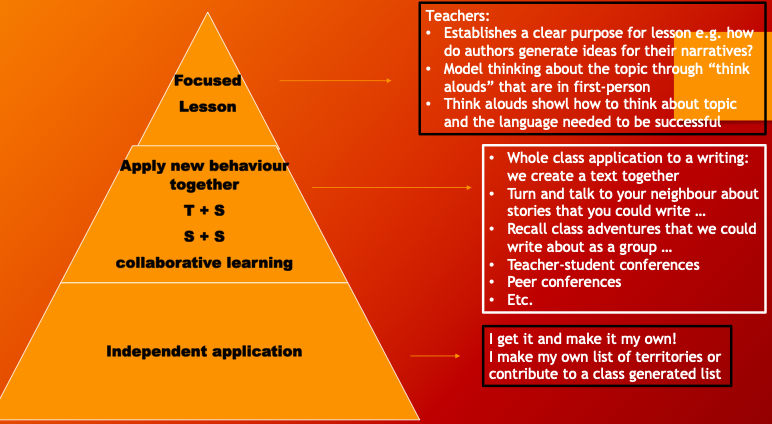Looking at my learning pod’s blueprint assignment and where we are headed with our interactive resource, one major way that we are working to support students through their progression of mastering a new skill (perimeter in our case) is by structuring our lessons to reflect the Gradual Release of Responsibility model. Here, “scaffolds” are employed to temporarily aid learners in building skills at the beginning, and are slowly taken away as the they become more proficient in the skill itself. For instance, as shown in the image embedded below, a teacher may begin by introducing a skill with a focused lesson and clear learning outcomes, than move forward to having students practice the skill in a collaborative way such as in small groups where they can receive feedback, and then finally give students the opportunity to apply the skill independently. We have integrated a combination of focused lessons, class discussions, and partner work before an independent activity requiring students to put what they have learned together. By following a GRR format in our design plan, we can ensure that all students are receiving the assistance that they need because, with these strategic scaffolds dividing how the content is taught, is becomes hard for anyone to become “lost along the way.” Specifically, if a class is having a particularly hard time practicing a skill collaboratively for example, this would be a great indicator that the students are not ready to move on to independent application, and subsequently that the teacher should return to the focused lesson.

Additionally, in terms of the Universal Design for Learning principles, our first lesson of the unit focuses on students reviewing how to measure properly with a ruler and activating any applicable prior knowledge, as this is a necessary ability for other key concepts to be taught later on. The preceding is congruent with checkpoint 3.1 “activate or supply background knowledge.” As well, we have made an effort to include a method of formative assessment in each lesson, such as through written or verbal feedback, which would meet the checkpoint 8.4, ” increase mastery-oriented feedback.”
I wanted to briefly discuss a video that helped me to understand what, as a future educator, I should be striving for in order to make my classroom inclusive; Shelley Moore uses bowling as an analogy for reaching students. She says that, like in bowling, most teachers will aim their lessons at the “middle” group of students. But, unfortunately what ends up happening is that the outside groups, which are those that need the most support and the most challenge, get left out, and teachers end up having to choose one over the other. So, instead of targeting he middle, Moore explains that we must enter with our lesson on a “curve” and change our aim to reach the students that are the furtherest and hardest to get to, which will result in a domino effect that extends to all learners. This idea truly resonated with me, as it pushed me to think more critically about what can be done to remove barriers rather than make things solely fair or equitable, as emphasized in the UDL principles.
Ross Greene similarly addresses this issue relevant to reducing barriers by highlighting why its critical to approach teaching with the simple philosophy “kids do well when they can” rather than “kids do well when they want to.” In this way, educators can evaluate what is getting in the way of a student’s success, rather than try to make kids “want to,” succeed, which typically involves the use of rewards and punishments that can hinder intrinsic motivation to learn. I love this phrase as in challenging situations it helps me to consider external dynamics and put things into perspective, as well motivates me to channel any frustration into finding a solution to the problem at hand.
I did some research for myself to try and find other examples of engineered Universal Designs other than curb cuts. One that grasped my attention were Oxo grips – the soft, non-slip, black handles found on kitchen gadgets like can openers and spatulas. This convenient product was in fact developed by Sam Farber, who’s wife was having trouble holding a vegetable peeler due to arthritis! This is a perfect example of a feature that may have been designed to meet a specific need, but simultaneously has benefitted other users. On this note, and as Heidi talks about in her post, in a school setting when one student is need of a certain accommodation, than educators should ideally adjust their lessons to make that support available to others as, just like the Oxo grips, it could be advantageous to everyone. I also feel that it’s important to add that creating a “culture” of healthy communication around expressing needs in the classroom is so critical for students to develop self-awareness and autonomy. Does anyone have any thought about this? I think modelling expression of needs ourselves as teachers would be a great start! Thanks for reading!
June 21, 2021 at 6:07 pm
I thought the bowling analogy video was great and shared some true points. It seems like there is still some room for improvement for inclusive learning design. Thanks for sharing!